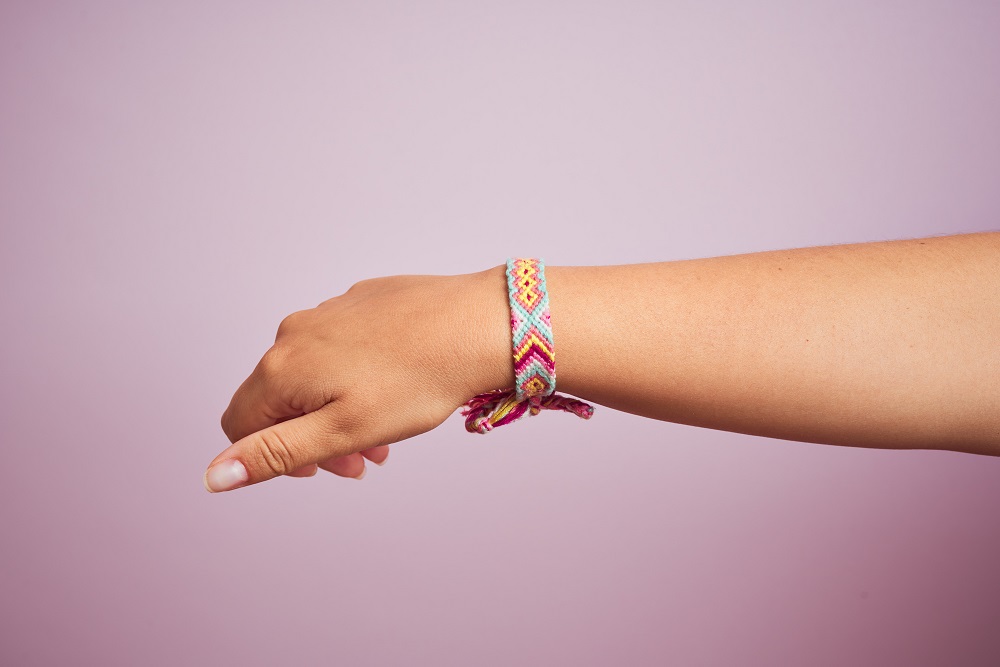The allure of a sliding knot bracelet lies in its adjustable nature, allowing it to fit any wrist size beautifully. However, over time, the wear and tear can compromise its delicate knots, disrupting its charm and leaving it ill-fitting. This article comes to the rescue with step-by-step guidance and tips on fixing a sliding knot bracelet, ensuring it retains its snug, perfect fit. Dive into this guide to seamlessly restore the elegance of your cherished accessory, eliminating any need for awkward adjustments.

A sliding knot bracelet is a versatile and adjustable accessory that has gained popularity for its simplicity and ease of customization.
Unlike traditional bracelets with fixed closures, sliding knot bracelets feature a sliding mechanism that allows wearers to easily adjust the length of the bracelet to fit their wrist comfortably. This innovative design makes these bracelets suitable for a wide range of wrist sizes, offering a one-size-fits-all solution.
The key element of a sliding knot bracelet is the adjustable knot itself, often referred to as a "sliding knot" or "adjustable knot." This knot enables the wearer to tighten or loosen the bracelet effortlessly by sliding it along the cords or strings used in the bracelet's construction.
While sliding knot bracelets are known for their user-friendly design, there are common issues that wearers may encounter, necessitating attention and fixing. Here are some of the typical problems associated with sliding knot bracelets:
1.Loose Knots: Over time, the sliding knots may become loose, leading to a slack bracelet.
2.Friction Wear: Continuous sliding of the knots can cause friction wear on the cords, particularly if they are made of softer materials.
3.Knot Slippage: In some cases, the knots may slip, causing the bracelet to unintentionally loosen.
4.Cord Breakage: With frequent use, the cords of a sliding knot bracelet may experience wear and tear, leading to breakage.
When it comes to fixing common issues with sliding knot bracelets, having the right tools and materials on hand is essential. Whether you're addressing loose knots, friction wear, knot slippage, or cord breakage, the following items will help you effectively troubleshoot and repair your sliding knot bracelet:
1.Fine-tip Tweezers or Needle-Nose Pliers: These precision tools are invaluable for adjusting and tightening sliding knots. Their slim design allows for easy maneuvering between the cords, ensuring a secure and precise fix.
2.Clear Nail Polish: A small bottle of clear nail polish can be used to add extra grip to sliding knots, preventing unwanted slippage. Applying a thin layer to the knots and allowing it to dry provides additional stability to the bracelet.
3.Replacement Cord: In the event of cord breakage, having a spare length of the same or similar material is crucial. Ensure that the replacement cord matches the original in both thickness and color for a seamless repair.
4.Scissors: A pair of sharp scissors is necessary for cutting and trimming cords during repairs. Use them with precision to create clean cuts and maintain the overall aesthetics of the sliding knot bracelet.
5.Lighter or Fray Check: For cords prone to fraying, a lighter can be used to carefully melt the ends, preventing further unraveling. Alternatively, fray check, a specialized adhesive, can be applied to reinforce and secure the cord's edges.
6.Flat Surface: A flat and stable surface provides a suitable workspace for fixing sliding knot bracelets. This ensures that you can focus on the intricate details of the repair without any unnecessary distractions or challenges.
7.Magnifying Glass (Optional): For intricate repairs or if working with smaller cords, a magnifying glass can enhance visibility, making it easier to inspect and fix the sliding knots with precision.
Having these tools and materials readily available allows you to address issues with your sliding knot bracelet promptly and effectively.
Now with the basic understanding and tools down, let's go for the steps on how to fix sliding knot bracelets. Here's a step-by-step guide:
It's essential to start by inspecting the sliding knot for any twists or tangles. These can hinder the smooth movement of the bracelet and may lead to discomfort when worn.
To address twists or tangles, use a thin tool like tweezers or a needle-nose plier to delicately untangle the cords. Exercise caution to avoid causing damage to the bracelet during this process.
Once untangled, straighten the bracelet strands to ensure they move seamlessly through the sliding knot. This step is needed to achieve a comfortable and visually appealing fit.
If the bracelet ends feel stiff, a small amount of clear nail polish can add flexibility and prevent further fraying. Apply the polish to the ends and let it dry completely before wearing.
For smooth adjustments, lubricate the sliding knot with a drop of clear oil. This minimizes friction, allowing the knot to glide effortlessly along the cords.
Excess cords can affect the bracelet's aesthetics and functionality. Trim any surplus material with sharp scissors for a clean and polished look.
After making adjustments, test the sliding knot to ensure it moves smoothly along the cords. This step helps confirm that the bracelet is now comfortable and adjustable.

To ensure a seamless experience and prevent common sliding knot issues, it's critical to implement preventative measures. Consider the following tips for maintaining the stability and functionality of sliding knots:
.Secure Tightening: Ensure knots are tightly secured to avoid accidental loosening by applying firm, even pressure and double-checking tightness.
.Friction-Enhancing Materials: Use materials with high friction to improve knot stability, selecting those known for their grip.
.Knot and Rope Compatibility: Match knots with specific ropes and uses, researching suitable knots for the rope type and intended application.
.Regular Inspections: Periodically inspect and re-tie knots, especially after extensive use, to maintain security.
.Clean Ropes: Keep ropes clean to preserve friction, especially important after outdoor use to prevent slippage.
.Minimize Sharp Bends: Reduce stress on knots by avoiding sharp bends in ropes, opting for smoother curves.
.Proper Tying Techniques: Learn and practice correct knot-tying methods to enhance knot strength and reliability.
.Moderate Force: Avoid excessive force when tightening to prevent damage, applying gradual pressure.
If you're looking to add a touch of style and meaning to your wrist game, consider the C·QUAN CHI Sliding Knot Bead Bracelet.
This adjust bracelet features a delightful mix of 5mm pearls and 1mm Miyuki beads, crafted from high-quality MIYUKI seed beads, shell accents, and durable waxed cord. Suitable for any wrist size (6"-10"), it is perfect for family, friends, children, and more. You can wear it during holidays, parties, or any occasion.
And there you have it – a complete guide on how to fix a sliding knot bracelet with tips to rescue your sliding knot bracelet from any hiccups. Now you're armed with the know-how to bring back the charm of your favorite wrist bling. No more struggling with wonky knots! Therefore, give it a shot, and revel in the satisfaction of knowing how to fix a sliding knot bracelet like a pro.
If your sliding knot bracelet has loosened over time, you can easily tighten it. Hold one end of the bracelet near the sliding knot and pull the other end gently. Simultaneously, slide the knot towards the tightened end. Repeat until you achieve the desired fit. Ensure both ends have even tension for a balanced appearance.
Yes, you can replace the cord in your sliding knot bracelet if it's damaged or worn. Carefully untie the existing knots, remove the old cord, and replace it with a new one. Ensure the replacement cord matches the original in thickness and material to maintain the bracelet's intended look and functionality. Alternatively, you can explore the latest sliding knot bead bracelets for a fresh and updated style.
In some cases, you can fix a sliding knot bracelet without cutting the cord. If the issue is minor, try readjusting the knots by pulling the cords in opposite directions. Apply clear nail polish to stiff ends, lubricate the sliding knot, and test for smooth adjustments. If the problem persists, consider retying the knots without cutting the cord for a non-invasive fix.
Discover the art of crafting a stylish bandana bracelet and learn how to make a bandana bracelet to create your own unique fashion statement.
Read MoreLearn how to adjust metal watch bracelets effortlessly using step-by-step instructions and expert tips to ensure your watch fits perfectly.
Read MoreLearn how to clean a metal watch bracelet effectively step-by-step and with tips to keep your timepiece looking pristine and shiny.
Read MoreCan a bracelet be worn as an anklet? Find out whether a bracelet can be worn as an anklet and explore your creative side with unique styling ideas.
Read More